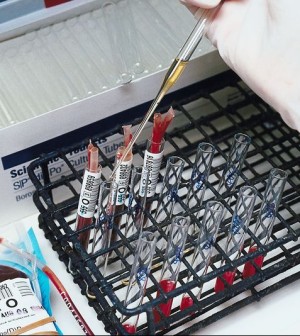- Navigating Your Midlife Crisis: Embracing New Possibilities
- City Raccoons Showing Signs of Domestication
- Mapping the Exposome: Science Broadens Focus to Environmental Disease Triggers
- One Week Less on Social Media Linked to Better Mental Health
- Your Brain Changes in Stages as You Age, Study Finds
- Some Suicide Victims Show No Typical Warning Signs, Study Finds
- ByHeart Formula Faces Lawsuits After Babies Sickened With Botulism
- Switch to Vegan Diet Could Cut Your Greenhouse Gas Emissions in Half
- Regular Bedtime Does Wonders for Blood Pressure
- Dining Alone Could Mean Worse Nutrition for Seniors
Tight Blood Sugar Control Helps Fight Diabetic Eye Disease

Intensive blood sugar control appears to reduce the risk of eye disease progression in people with type 2 diabetes, a new study says.
People with type 2 diabetes are at risk for the eye disease called diabetic retinopathy. This condition damages tiny blood vessels in the retina, the light-sensitive tissue in the back of the eye.
Researchers compared type 2 diabetes patients who received either intensive therapy or standard therapy to control blood sugar. To measure how well the therapy worked, people in the study had hemoglobin A1C tests. The A1C test estimates several months of blood sugar levels.
People are diagnosed with diabetes when their A1C is 6.5 percent or higher, the U.S. National Institute of Diabetes and Digestive and Kidney Disease says. In general, the goal for people with type 2 diabetes is to have an A1C of less than 7 percent, according to the American Diabetes Association. But this goal can be changed, depending on someone’s individual health.
In the new study, participants on intensive therapy had average hemoglobin A1C levels of 6.4 percent when the research ended. The standard therapy group had A1C levels that averaged 7.7 percent, the researchers said.
The researchers checked the study volunteers’ eye health four years after treatment ended. At that point, A1C levels were almost the same — 7.8 for the intensive group and 7.9 for the standard group. The researchers found the risk of diabetic retinopathy progression for patients in the intensive therapy group was 6 percent. In the standard therapy group, that rate was 13 percent.
“This study sends a powerful message to people with type 2 diabetes who worry about losing vision,” said lead author Dr. Emily Chew. She is deputy director of the division of epidemiology and clinical applications at the U.S. National Eye Institute.
“Well-controlled [blood sugar] has a positive, measurable and lasting effect on eye health,” she said in an institute news release.
Previous studies have reported similar findings, the researchers said.
Almost 8 million people have diabetic eye disease in the United States. The eye condition is the leading cause of vision loss among working-age Americans, the researchers said.
The study was scheduled to be presented Saturday at the American Diabetes Association’s annual meeting, in New Orleans. Findings presented at meetings are generally viewed as preliminary until published in a peer-reviewed journal.
More information
The U.S. National Eye Institute has more about diabetic retinopathy.
Source: HealthDay
Copyright © 2025 HealthDay. All rights reserved.










